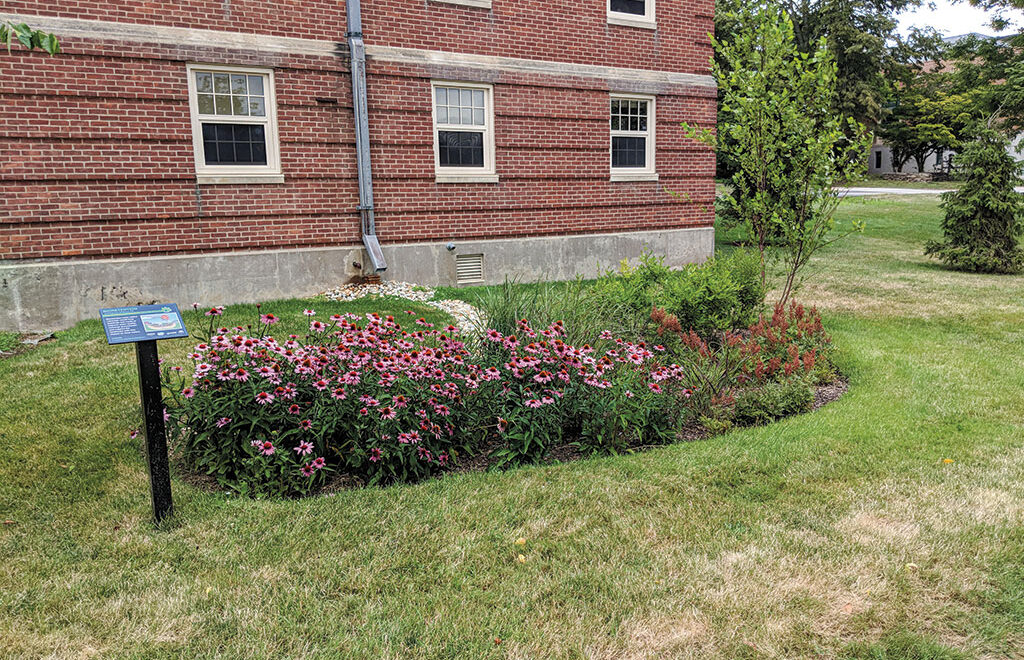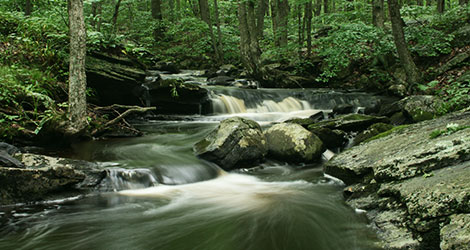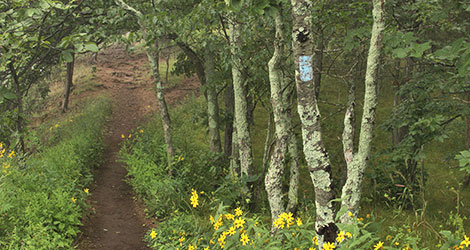
Soaking Up the Rain
By Michael Dietz
As the climate warms and the Northeast experiences more frequent and heavier rain events, you’ve likely heard the term “rain gardens.” But what is a rain garden and why would you want one at your home? Well, before we get to that, we need to talk about stormwater runoff. Stormwater runoff is generated when there is too much rain for it all to sink into the ground. In undeveloped areas, like forests and fields, most rainfall is absorbed by the ground and then moves slowly through the soil. This natural purification process, however, has been interrupted by the impervious surfaces—such as roads, parking lots, and houses—that we put on the landscape. Impervious surfaces do not allow water to sink into the ground, and in many places the runoff from these surfaces gets piped directly to nearby waterways. This has negative impacts on aquatic life, including loss of habitat and over-enrichment of waters with nutrients, which can lead to toxic algae blooms and low oxygen. Rain gardens are one form of green stormwater infrastructure that can help your landscape function more like it did before the impervious surfaces were added.
Okay, so now you know why we need rain gardens. But how do they work, and can you install one at your home? A rain garden is quite simple in concept: it is a depression in the landscape that collects stormwater runoff. The plants used in rain gardens are native to this area and grow around the edges of wetlands. This means they can tolerate standing water sometimes and dry conditions at other times. This raises an important point: rain gardens are not wetlands and should not hold water for more than a day after a rain event. Their primary function is to allow the water to sink into the ground so it’s dry before the next storm. Because of this, there are some important considerations when you are determining whether a rain garden will work at your home, including where to place your garden, how water will get to your garden, the suitability of soils, and the proximity to buildings. UConn’s CT NEMO (Nonpoint Education for Municipal Officials) maintains a website and app with detailed information and short video clips to help you evaluate your site. There are also tools to help you size your rain garden and a plant database to help you choose the best plants depending on your sun exposure and desired aesthetic.
Rain gardens are one form of green stormwater infrastructure that can help your landscape function more like it did before the impervious surfaces were added.
Once you’ve decided to install a rain garden, you need to consider whether you can do the work yourself or if you’ll need to hire a contractor. If you’re installing a small residential rain garden to contain runoff from part of a 1,000-square-foot building footprint, you can likely dig it by hand if your soils are not overly compacted. For comparison, a rain garden to treat runoff from one downspout at my cape-style home would be about 40 square feet, which means you’d need to remove nearly a cubic yard of soil. If you (or a family member who has been volun”told” to help) can manage this kind of work, you’re all set. Then you install the plants, which is similar to digging in plants in any other landscaped area. Next you need to decide how you are getting water to the garden. You could run a pipe from your downspout or make a stream bed out of stone to get water from the downspout to the garden. If you have a basement, I recommend keeping a rain garden at least 10 feet away from your foundation to prevent water from moving back towards your basement. Then you need to install a thin layer of mulch to help keep weeds down and moisture in for the plants. The decision of whether to Do It Yourself or hire a professional to install the rain garden will depend on whether you can handle this type of physical work. Once installed, the maintenance of a rain garden is similar to caring for perennial plants in a landscaped area.
In addition to reducing stormwater runoff, rain gardens can also provide wildlife habitat. Plants can be chosen that will attract pollinators. Butterfly milkweed (Asclepias tuberosa) and Joe-Pye weed (Eutrochium spp.) are great rain garden plants that will attract lots of pollinators to your garden in addition to providing beautiful blooms and splashes of color. Winterberry (Ilex verticillata) shrubs provide important food sources for birds in the winter months. Inkberry (Ilex glabra) shrubs also provide berries for birds and their leaves stay green throughout the winter, providing nice visual appeal.
Given all of these positive benefits, I leave you with this question: why wouldn’t you want a rain garden at your house?
For more detailed information on how to properly design and install a rain garden, visit nemo.uconn.edu/raingardens, use our smartphone app at rgapp.nemo.uconn.edu, or watch our free, multi-part course at s.uconn.edu/raingardencourse.
Michael Dietz is an Extension Educator at the University of Connecticut, where he is also a joint faculty member in the Department of Natural Resources and the Environment. Dr. Dietz has been doing outreach and research on stormwater issues for more than 20 years. In his current role, he is part of the Center for Land Use Education and Research (CLEAR) and directs the Connecticut Institute of Water Resources. A Connecticut native, he lives in the Quiet Corner with his wife, flock of chickens, herd of cats, and a loving teenage daughter.




